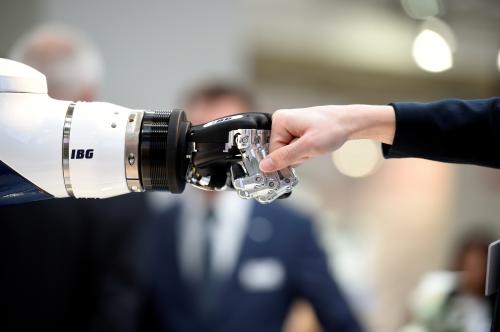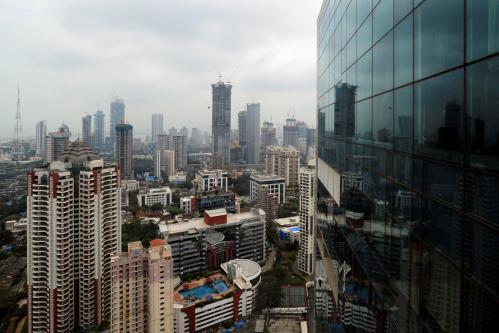Content from the Brookings Institution India Center is now archived. After seven years of an impactful partnership, as of September 11, 2020, Brookings India is now the Centre for Social and Economic Progress, an independent public policy institution based in India.
Advances in artificial intelligence and data analytics are propelling innovation in many parts of the world.[1] China, for example, has committed $150 billion towards its goal of becoming a world leader by 2030.[2] And while the United States government is investing only $1.1 billion in non-classified AI research, its private sector is spending billions in fields from finance and healthcare to retail and defense.[3] This is transforming a number of different sectors.[4]
Yet India is playing catch-up in these vital areas. It devotes only 0.6 percent of GDP to R&D, well below the 2.74 percent in the United States and 2.07 in China.[5] Its limited investment has slowed innovation and put the country at an economic disadvantage. PricewaterhouseCoopers estimates that worldwide, AI will “increase global GDP by $15.7 trillion, a full 14%, by 2030.” But of this, $7 trillion is likely to accrue to China, $3.7 trillion to North America, and only $957 billion to India.[6]
In the last three years, India has attracted less than $100 million in AI-oriented venture capital financing.[7] According to writer Ananya Bhattacharya, “the sector is dominated by American firms like Accenture, Microsoft, and Adobe, which have their innovation centres here [in India]. Home-grown efforts on the academic, business, and investor fronts are few.”[8] Seventy percent of the AI research in the nation occurs in non-Indian firms. As an illustration, in looking at research publications, 62 percent of it comes from Google and IBM employees working in India and “there is only one Indian company in the top 10.”[9]
There is growing AI interest, however, as India starts to invest additional resources and deploy new AI applications. This year, the national government has doubled its investment in its innovation program known as Digital India to Rs3,063 crore (or $477 million) in order to fund advances in AI, machine learning, and 3-D printing.[10] The Ministry of Commerce and Industry has developed an AI Taskforce to develop policies that encourage innovation in these areas. Its recent report emphasized the need for greater investment, more AI research, revamping of school curricula, and additional innovation by the private sector.[11]
As a sign of the increased activity level, AI applications are emerging in a number of different areas that show considerable promise:
Finance
Fraud and corruption are major challenges for financial institutions and governmental overseers. A report by PricewaterhouseCoopers found that
“large financial bodies such as payment regulators handle billions of transactions each day across different channels such as ATM withdrawals, credit card payments, and e-commerce transactions. Advanced analytical techniques and ML [machine learning] algorithms, combined with human expertise allow institutions to flag transactions as potentially fraudulent at the time of occurrence and hence contain the damage as early as possible.”[12]
These become particularly relevant given the recent discoveries of major fraudulent transactions in several large public and private sector banks in India. AI and ML techniques can be employed to create early warning systems and minimize human errors.
Healthcare
Advanced software helps health providers assess symptoms, diagnose disease, and plan appropriate treatments. According to writer Prakash Mallya, “the healthcare industry is relying on AI to fine-tune the accuracy of medical predictions and choose a fitting line of treatment.”[13] AI is a way to improve the quality of care while also containing medical costs. Beyond diagnosis and treatment, AI techniques and ML algorithms can also fine-tune interventions in public health policy across the country. There are large variations in the disease burden and demand for care across states of India, as well as across districts within large states such as Uttar Pradesh. The government can design real-time health interventions targeting specific populations, which is critically needed in Indian health policy.
Manufacturing
AI offers the hope of improving supply chain management and resource utilization. Both of these factors are vital for manufacturing and movement up the value chain. Factories and warehouses have difficulty managing logistics and forecasting the need for particular products. Software can help track supplies and make sure companies have what they need to make their products.[14] This is particularly important given the long term strategic role of the manufacturing sector for job creation and raising overall productivity in the economy.
Crime Prediction
Indian authorities are using AI developed abroad to anticipate crime and intervene before it happens. For example, an Israeli company called Cortica is working with the Best Group “to analyze the terabytes of data streaming from CCTV cameras in public areas. One of the goals is to improve safety in public places, such as city streets, bus stops, and train stations.” The firm is “looking for ‘behavioral anomalies’’ that signal someone is about to commit a violent crime.”[15] Given the various security risks that India faces, application of AI and ML can be instrumental in maintaining law and order as well as neutralizing extremist threats across states of the country.
Precision Agriculture
Farmers are seeking to deploy AI to increase crop yields. Using sensors that measure soil temperature and moisture, these software systems identify the ideal time for planting and harvesting, and help farmers make efficient use of pest control and fertilization. Suhas Wani, Director of the International Crop Research Institute notes “sowing date as such is very critical to ensure that farmers harvest a good crop. And if it fails, it results in loss as a lot of costs are incurred for seeds, as well as the fertilizer applications.”[16] The usage of AI is also potentially significant in weather insurance, where accurate estimates of local weather conditions are instrumental in designing insurance policies for agriculture and other industries.
Based on these examples, it is clear India needs to encourage greater AI investment, see more support from government agencies, make it possible for private firms to develop novel applications, reform education programs in order to generate better AI training, and encourage the venture capital community to invest in India. Adoption of these actions would help India expand its GDP and build greater economic prosperity in the future.
[1] Darrell M. West, The Future of Work: Robots, AI, and Automation, Brookings Institution Press, 2018.
[2] Paul Mozur, “China Sets Goal to Lead in Artificial Intelligence,” New York Times, July 21, 2017, p. B1.
[3] Greg Brockman, “The Dawn of Artificial Intelligence,” Testimony before U.S. Senate Subcommittee on Space, Science, and Competitiveness, November 30, 2016.
[4] Darrell M. West and John R. Allen, “How Artificial Intelligence is Transforming the World,” Brookings Institution report, April 24, 2018.
[5] Darrell M. West, “How the Innovation Economy Leads to Growth,” A Hearing of the Joint Economic Committee of the U.S. Congress, April 25, 2018 and Ananya Bhattacharya, “India Hopes to Become an AI Powerhouse By Copying China’s Model,” Quartz, February 13, 2018.
[6] PricewaterhouseCoopers, “Sizing the Prize: What’s the Real Value of AI for Your Business and How Can You Capitalize?” 2017 and Rekha Menon, Madhu Vazirani, and Pradeep Roy, “Rewire for Growth: Accelerating India’s Economic Growth with Artificial Intelligence,” Accenture, 2017.
[7] Ananya Bhattacharya, “India Hopes to Become an AI Powerhouse By Copying China’s Model,” Quartz, February 13, 2018.
[8] Ananya Bhattacharya, “India Hopes to Become an AI Powerhouse By Copying China’s Model,” Quartz, February 13, 2018.
[9] Smita Sinha, “Where Artificial Intelligence Research in India is Heading,” Analytics India, March, 2018.
[10] Ananya Bhattacharya, “India Hopes to Become an AI Powerhouse By Copying China’s Model,” Quartz, February 13, 2018.
[11] Artificial Intelligence Task Force, “Report of the Artificial Intelligence Task Force”, The Ministry of Commerce and Industry, Government of India, March, 2018.
[12] Arnab Basu and Sudipta Ghosh, “Advance Artificial Intelligence for Growth: Leveraging AI and Robotics for India’s Economic Transformation,” PriceWaterhouseCoopers, April, 2018, p. 13.
[13] Prakash Mallya, “India Wants to Go All in on AI, But Must First Tackle Shortage of Talent and Data,” Forbes, January 2, 2018.
[14] Arnab Basu and Sudipta Ghosh, “Advance Artificial Intelligence for Growth: Leveraging AI and Robotics for India’s Economic Transformation,” PriceWaterhouseCoopers, April, 2018, p. 13.
[15] John Quain, “Crime-Predicting A.I. Isn’t Science Fiction. It’s About to Roll Out in India,” Digital Trends, April 11, 2018.
[16] Microsoft, “Digital Agriculture: Farmers in India Are Using AI to Increase Crop Yields,” undated.
The Brookings Institution is committed to quality, independence, and impact.
We are supported by a diverse array of funders. In line with our values and policies, each Brookings publication represents the sole views of its author(s).












Commentary
Artificial intelligence and data analytics in India
May 17, 2018